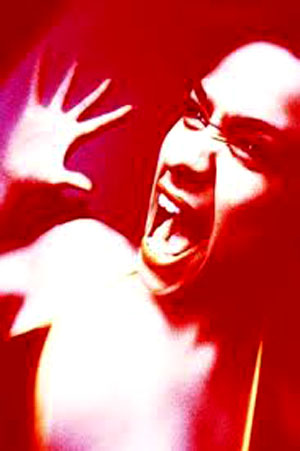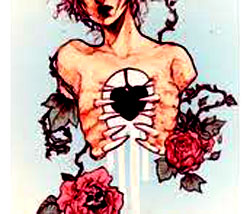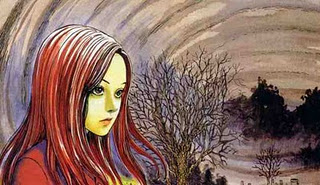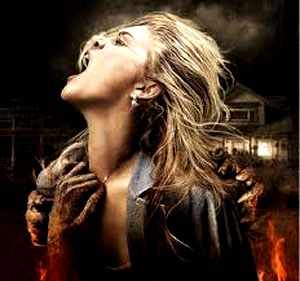For Love of Fear
“Humans are the only creatures that actively seek out fearful experiences.
We take roller coaster rides. We skydive. We go to scary movies.
We even pay money to do these things.” – Dirk Eitzen
The Society for Cognitive Studies of the Moving Image
 Like most married Americans, I watch television with my wife. We usually share reactions; laughter at the same jokes, intrigue at plot twists, shock at surprises, but when horror movie commercials come on, our reactions couldn’t be more opposite. I gape, she cringes. I love horror movies, and books, and video games. She does not. Today we answer the question that has no-doubt been in her mind, and the minds of other horror-loving-lover spouses, “What’s wrong with me?” as well as the question that she’s actually asked me, on occasion, “Why do you like to be scared?”
Like most married Americans, I watch television with my wife. We usually share reactions; laughter at the same jokes, intrigue at plot twists, shock at surprises, but when horror movie commercials come on, our reactions couldn’t be more opposite. I gape, she cringes. I love horror movies, and books, and video games. She does not. Today we answer the question that has no-doubt been in her mind, and the minds of other horror-loving-lover spouses, “What’s wrong with me?” as well as the question that she’s actually asked me, on occasion, “Why do you like to be scared?”
Let’s talk about fear. According to a 2010 article by Dirk Eitzen of The Society for Cognitive Studies of the Moving Image, “fear is such an effective life-saving response that it is one of the most basic and primitive ‘emotions’…the fear response is buried in the most primitive parts of the brain, sometimes called the ‘reptile brain.’ At bottom, fear is a danger avoidance mechanism. It anticipates possible harm and then prompts us to avoid it. It is forward looking. That’s why we have it.” That anticipation of possible harm will be key to this discussion.
In terms of sides of the discussion, those who study and investigate this topic “generally use one of two theories to explain why people like horror movies,” as noted in Science Daily. “The first is that the person is not actually afraid, but excited by the movie. The second explanation is that they are willing to endure the terror in order to enjoy a euphoric sense of relief at the end.” This article highlighted a new study by Eduardo Andrade (University of California, Berkeley) and Joel B. Cohen (University of Florida) which first appeared in the August issue of the Journal of Consumer Research decrying both of these perspectives on the love, and personal function of horror movies. In fact, the study argued against the either-or model of the debate, asserting that there are multiple benefits and emotional stimuli involved.
A great horror movie hangs on three spikes, Story, Art and Music. To this end I’ve brought together a writer (Me) an artist and a musician who all are lovers of horror. Chuck Regan, “Illustrator and writer for fun and hopefully-eventually-profit, and a web designer for not-so-much-fun” has loved horror ever since reading “an old horror comic book about a disfigured child locked in an attic,” or watching the “Hammer film, ‘The Screaming Skull’.” He is a long-time dark comic book writer-artist, graphic designer of beauty and villainy and author of the forthcoming “Children to Avoid,” a creepy children’s book for adults which incorporates his talent for the macabre.
Christina Ward was first welcomed into the world of horror by Freddy in Nightmare on Elm Street and considers the horror experience “like jumping out of an airplane- the adrenaline rush is addicting!” Christina is the singer/songwriter/banjo player for The Great Afternoon, who’s bright name pokes fun at their haunting, sometimes dark tone. The music of The Great Afternoon, with its lingering melodies and deft tempo changes could find its way into any horror soundtrack—and probably should.
Feelings, a Rainbow of Feelings

According to Steph Hendry of Media Studies “Uses and Gratification Theory” defines “multiple pleasures that might be experienced when watching horror films” from the simple emotions of “Identification, Entertainment, Diversion, Escapism, Voyeurism, Social Interaction, and Empathy” to the complex concepts of “Catharsis or Vicarious experience, Perception of anti-mainstream activity, Playing out cultural/personal fears, and Masochism (&/or sadism).” Interestingly, the horror experience can, apparently serve as both “Confirmation of dominant ideologies and values” or as “‘Acting out’ – challenging enforced values and repressions” depending on the viewer’s ideological bent.
But from a less clinical perspective, the stirring of horror is much more straight forward. Christina Ward seeks the chance to “experience things that would be horrifying to go through without actually having to go through those experiences” which reinforces Eitzen’s research that “By entertaining imaginary dangers, we rehearse responses to actual or possible dangers. In this way, we develop important survival skills [and] take situations, including painful or sad situations such as death, and think through how we might or should respond to them.”
“Good horror is something that, due to its concepts or craftsmanship in storytelling, can be overlaid readily onto my current reality,” which Chuck Regan said is his greatest emotional pleasure, “’crossing over’ into the unknown and inspiring my already overactive imagination is the best experience. Could there be a slithering tentacled thing hanging from the rafters? If I have to check before I am comfortable, then SCORE!” Eitzen would call that “Cognitive Mastery…by trying to comprehend it, we take a step toward being able to manage or control it. This is a uniquely human capacity, but it addresses a basic biological need, by helping us feel and be safe.”
What Makes Your Spine (or Scalp) Tingle?
 As noted in Fear: A Psychophysiological Study of Horror Film Viewing a Texas State University Study, “the experience of fear and its physiology is a group effort provided by multiple systems within the body and in the brain” and one of the end results of that effort is to flood the bloodstream with a cocktail of “adrenaline and cortisol, increasing blood pressure and increasing the metabolic rate needed to react appropriately to survive.” All this is true, plus it feels dandy.
As noted in Fear: A Psychophysiological Study of Horror Film Viewing a Texas State University Study, “the experience of fear and its physiology is a group effort provided by multiple systems within the body and in the brain” and one of the end results of that effort is to flood the bloodstream with a cocktail of “adrenaline and cortisol, increasing blood pressure and increasing the metabolic rate needed to react appropriately to survive.” All this is true, plus it feels dandy.
While the physical manifestations are slightly different in each person—such as, both Ward and Regan get cold or sweaty hands but Ward’s “heart rate spikes” while Regan’s “scalp tingles”—the ultimate physiological draw is really a no brainer. “At the most basic level,” Eitzen found, “the arousal engendered by the thought of sex is no different than the arousal produced by fear. Adrenaline is adrenaline.”
It’s All in Your Head

The Texas State University Study pinpointed “the amygdalae, a collection of nuclei in the medial temporal lobes of the brain” as the “fundamental basis and center for the processing of fear in the human emotional complex.”
But that does not pin-point why both our horror lovers found The Exorcist as the most frighteningly enjoyable movie, but I am Legend made Ward almost walk out of the theater and the Alien “Chest Buster Scene, in the theater” did make 11 year old Chuck Regan spend “the next third of the film in the lobby.”
Of course, The Society for Cognitive Studies of the Moving Image points the way. “The brain’s fear response and thereby, the horror genre writer, pushes three buttons, so to speak. It galvanizes attention and so orients the body and the mind toward danger or the possibility of danger. It prepares the body for action, by releasing adrenaline into the bloodstream and tensing muscles, among other things. And it takes control of thought, pushing danger or the possibility of danger to the forefront of awareness. This is why it is extremely difficult if not impossible to turn fear off by simply willing it away” and why when our fear-centers are too stimulated flight will happen.
If a horror crafter hits that sweet spot, the just-scary-enough spot, we get “galvanized attention, tense muscles, mind focused on the possibility of harm…we use the same mental machinery to process the idea of danger whether it is danger to the self or danger to someone else. This applies even to characters in movies. We know they are just actors, of course. Still, the fear machinery churns away, beneath the level of this conscious stuff.” Eitzen concludes that “We cannot turn this machinery off. That’s what is so fun about scary movies.”
The Bottom of the Spiral
“Horror movies I think are the closest thing we have to an active mythology –
to provide warning signs for behavior and how far is too far to adventure into the unknown,
and how to maintain our humanity while we are in danger.”
-Chuck Regan, Illustrator and Writer
Andrade and Cohen asserted in their novel study that “The assumption of people’s inability to experience positive and negative affect at the same time is incorrect…people experience both negative and positive emotions simultaneously — people may actually enjoy being scared, not just relief when the threat is removed” as previously thought.
This is no real surprise to all three of our horror lovers (myself included). Andrade and Cohen say “the most pleasant moments of a particular event may also be the most fearful” I say that—on this day of tricks, treats and candy—that we all like a little salty with our sweet. The trick is finding the right degree of each so that maximum pleasure is the result.
_________________________________________
Special thanks to Christina Ward and Chuck Regan for helping with this article. Please check out the sites of these two gifted, fine people. And Happy Halloween everyone.

